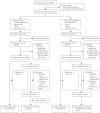Assisted partner services for HIV in Kenya: a cluster randomised controlled trial
- PMID: 27913227
- PMCID: PMC5291815
- DOI: 10.1016/S2352-3018(16)30214-4
Assisted partner services for HIV in Kenya: a cluster randomised controlled trial
Abstract
Background: Assisted partner services for index patients with HIV infections involves elicitation of information about sex partners and contacting them to ensure that they test for HIV and link to care. Assisted partner services are not widely available in Africa. We aimed to establish whether or not assisted partner services increase HIV testing, diagnoses, and linkage to care among sex partners of people with HIV infections in Kenya.
Methods: In this cluster randomised controlled trial, we recruited non-pregnant adults aged at least 18 years with newly or recently diagnosed HIV without a recent history of intimate partner violence who had not yet or had only recently linked to HIV care from 18 HIV testing services clinics in Kenya. Consenting sites in Kenya were randomly assigned (1:1) by the study statistician (restricted randomisation; balanced distribution in terms of county and proximity to a city) to immediate versus delayed assisted partner services. Primary outcomes were the number of partners tested for HIV, the number who tested HIV positive, and the number enrolled in HIV care, in those who were interviewed at 6 week follow-up. Participants within each cluster were masked to treatment allocation because participants within each cluster received the same intervention. This trial is registered with ClinicalTrials.gov, number NCT01616420.
Findings: Between Aug 12, 2013, and Aug 31, 2015, we randomly allocated 18 clusters to immediate and delayed HIV assisted partner services (nine in each group), enrolling 1305 participants: 625 (48%) in the immediate group and 680 (52%) in the delayed group. 6 weeks after enrolment of index patients, 392 (67%) of 586 partners had tested for HIV in the immediate group and 85 (13%) of 680 had tested in the delayed group (incidence rate ratio 4·8, 95% CI 3·7-6·4). 136 (23%) partners had new HIV diagnoses in the immediate group compared with 28 (4%) in the delayed group (5·0, 3·2-7·9) and 88 (15%) versus 19 (3%) were newly enrolled in care (4·4, 2·6-7·4). Assisted partner services did not increase intimate partner violence (one intimate partner violence event related to partner notification or study procedures occurred in each group).
Interpretation: Assisted partner services are safe and increase HIV testing and case-finding; implementation at the population level could enhance linkage to care and antiretroviral therapy initiation and substantially decrease HIV transmission.
Funding: National Institutes of Health.
Copyright © 2017 Elsevier Ltd. All rights reserved.
Figures
Comment in
-
Assisted partner services for HIV case-finding.Lancet HIV. 2017 Feb;4(2):e55-e56. doi: 10.1016/S2352-3018(16)30211-9. Epub 2016 Nov 30. Lancet HIV. 2017. PMID: 27913226 Free PMC article. No abstract available.
References
-
- Cates W, Jr, Toomey KE, Havlak GR, Bowen GS, Hinman AR. From the CDC. Partner notification and confidentiality of the index patient: its role in preventing HIV. Sex Transm Dis. 1990;17:113–14. - PubMed
-
- Arthur G, Lowndes CM, Blackham J, Fenton KA. Divergent approaches to partner notification for sexually transmitted infections across the European Union. Sex Transm Dis. 2005;32:734–41. - PubMed
-
- Centers for Disease Control and Prevention (CDC) Recommendations for partner services programs for HIV infection, syphilis, gonorrhea, and chlamydial infection. MMWR Recomm Rep. 2008;57(RR-9):1–83. - PubMed
-
- Hoxworth T, Spencer NE, Peterman TA, Craig T, Johnson S, Maher JE. Changes in partnerships and HIV risk behaviors after partner notification. Sex Transm Dis. 2003;30:83–88. - PubMed
Publication types
MeSH terms
Associated data
Grants and funding
LinkOut - more resources
Full Text Sources
Other Literature Sources
Medical


